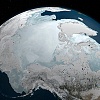Militarisation of the Arctic: (3) Canada
In
Log in if you are already registered
III. Canada
Stephen Harper: the rise and fall of Canada's defence budget
Since coming to power in 2006, Canada’s Conservative Prime Minister Stephen Harper has made support for the military the centrepiece of his campaign to garner support from voters disillusioned with the Liberal party’s policies towards veterans and military action abroad. Harper ratcheted up the country’s defence budget from the beginning of his first term until, unsurprisingly, just after the worldwide financial crisis when the government found itself strapped for funds. The budget rose from its levels under the Liberals (approx. $12 billion USD) to a peak of $17.9 billion USD for 2011-2012 before dropping back down to about $14.4 billion USD for the projected 2016-2017 budget[1]. Despite Harper’s initial largesse for the military it should be noted that a stronger military already constituted a top priority for the previous Liberal government under Paul Martin, and Harper’s focus on the military is therefore perhaps part of a larger trend[2].
The Arctic is of particular concern to Harper, who described it as the “heart of our Canadian identity” in the policy platform for his 2011 federal election campaign[3]. Especially as the Canadian Arctic becomes more viable as a commercial transport route, Canada has become increasingly vocal about the importance of Canadian sovereignty over its northern waters, much to the dismay of its northern neighbours. Canada, which defines the waters between its Arctic islands as a sort of inland sea over which it claims exclusive sovereignty, often comes into conflict with other Arctic states over shipping through its Arctic waters, as these states view them as international channels subject to laws governing international waters[4].
Military Expenditures: more isn't always more
In the interest of protecting these waters, regardless of their legal status, Harper has stepped up military exercises in the region. In 2011 his government approved the highly controversial purchase of 65 new fighter jets from US company Lockheed Martin without a bidding process open to other firms[5]. These jets, which constitute one of the most costly acquisitions in Canadian military history, were ostensibly bought to assist Canadian forces in ensuring Canadian sovereignty over the Arctic, but the costly planes turned out to be ill equipped for flights in harsh Arctic conditions[6]. Whether this miscalculation was the product of incompetence or corruption is unclear, but it does highlight the disconnect between fiery Canadian rhetoric of protecting Arctic sovereignty under Harper and the military’s actual ability to deliver on its promises.
Canada's Military Installations
Canada maintains its northern headquarters in Yellowknife, the capital of the Northwest Territories (NWT). This base, along with a further three forward operating locations (FOLs) in Inuvik (NWT), Rankin Inlet (Nunavut) and Iqaluit (Nunavut) serve as facilities for cooperation with the North American Aerospace Defence Command (NORAD), a joint defence organisation between Canada and the United States[7]. Canada also maintains the world’s northernmost military installation at the Canadian Forces Station in Alert, Nunavut[8]. Its unique location north of the 82nd parallel has made it a regional hotspot for scientific research and monitoring of the climate in the furthest reaches of the Arctic.
Due to its meagre budget in comparison with its southern neighbour, Canada has, of course, relied on cooperation with the United States to protect its vast northern territories through programmes like NORAD and its participation in the NATO military alliance. The United States’ presence in the Arctic, including its cooperation with Canada, will be covered in our next instalment.
For information on Russian military installations on the Arctic, see our first instalment. Information on the Nordic countries’ military presence can be found here.
For this project’s directory, click here.
[1] “Canada’s defence spending: Darkness falls again?”. The Economist. 19 March 2014. <http://www.economist.com/blogs/americasview/2014/03/canadas-defence-spending>
[2] Morin, David & Stéphane Roussel. “Autopsie de la politique étrangère de Stephen Harper: un examen préliminaire”. Canadian Foreign Policy Journal. 29 July 2014.
[3] “Here for Canada: Stephen Harper’s Low-Tax Plan for Jobs and Economic Growth”. Conservative Party of Canada. p 37. <http://www.conservative.ca/media/2012/06/ConservativePlatform2011_ENs.pdf>
[4] [4] “The Law of the Sea Convention and the Northwest Passage” – James Kraska, pp 272 273 <http://www.marad.dot.gov/documents/ARCTIC_Law_of_the_Sea_Convention_and_NorthWest_Passage.pdf>
[5] “Row over Canada F-35 fighter jet order”. BBC News. 16 July 2010. <http://www.bbc.com/news/world-us-canada-10667633>
[6] Humpert, Malte. “Canada’s New F-35 Stealth Fighter Lacks Ability to Communicate in the Arctic”. The Arctic Institute. 24 October 2011. <http://www.thearcticinstitute.org/2011/10/3245-canadas-new-f-35-stealth-fighter.html>
[7] "L'aviation royale canadienne : Protectrice du Canada". Royal Canadian Air Force. <http://www.rcaf-arc.forces.gc.ca/assets/AIRFORCE_Internet/images/map-carte-fra-2013-hr.jpg>
[8] “Canadian Forces Station Alert”. Royal Canadian Air Force. <http://www.rcaf-arc.forces.gc.ca/en/8-wing/alert.page>





